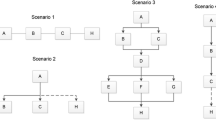Abstract
We develop and discuss the theoretical basis of a new criterion for ranking scientific institutions. Our novel index, which is related to the h-index, provides a metric which removes the size dependence. We discuss its mathematical properties such as merging rules of two sets of papers and analyze the relations between the underlying rank/citation-frequency law and the h-index. The proposed index should be seen as a complement to the h-index, to compare the scientific production of institutions (universities, laboratories or journals) that could be of disparate sizes.
Similar content being viewed by others
References and notes
J. E. Hirsch, An index to quantify an individual’s scientific research output, Proc. Nat. Acad. Science, 102 (2005) 16569–16572.
P. Ball, Index aims for fair ranking of scientists, Nature, 436 (2005) 900.
G. Saad, Exploring the h-index at the author and journal levels using bibliometric data of productive consumer scholars and business-related journals respectively, Scientometrics, 69(1) (2006) 117–120.
W. Glänzel, On the h-index — A mathematical approach to a new measure of publication activity and citation impact, Scientometrics, 67(2) (2006) 315–321.
T. Braun, W. Glänzel, A. Schubert, A Hirsch-type index for journals, Scientometrics, 69(1) (2006) 169–173.
L. Egghe, R. Rousseau, An informetric model for the Hirsch-index, Scientometrics, 69(1) (2006) 121–129.
J. F. Molinari, A. Molinari, A new methodology for ranking scientific institutions, Scientometrics, 75(1) (2008) 163–174, see also J. F. Molinari, A. Molinari, Imechanica post, http://www.imechanica.org/node/1031, posted March 13th 2007.
Thomson Scientific, ISI Web of Knowledge, http://portal.isiknowledge.com
G. Zipf, Human Behavior and the Principle of Least Effort, Cambridge MA: Addison-Wesley, 1949.
A. J. Lotka, The frequency distribution of scientific productivity, Journal of the Washington Academy of Science, 16 (1926) 317–323.
M. Sutter, M.G. Kocher, Power laws of research output. Evidence for journals of economics, Scientometrics, 51(2) (2001) 405–414.
R. Bailon-Moreno, E. Jurado-Alameda, R. R. Ruiz-Banos, J. P. Courtial, Bibliometric laws: Empirical flaws of fit, Scientometrics, 63(2) (2005) 209–229.
D. H. Zanette, S. C. Manrubia, Role of intermittency in urban development: a model of large-scale city formation, Physical Review Letters, 79(3) (1997) 0031–9007.
C. Furusawa, K. Kaneko, Zipf’s law in gene expression, Physical Review Letters, 90(8) (2003) 088102-1.
Author information
Authors and Affiliations
Corresponding author
Rights and permissions
About this article
Cite this article
Molinari, A., Molinari, JF. Mathematical aspects of a new criterion for ranking scientific institutions based on the h-index. Scientometrics 75, 339–356 (2008). https://doi.org/10.1007/s11192-007-1872-z
Received:
Published:
Issue Date:
DOI: https://doi.org/10.1007/s11192-007-1872-z




